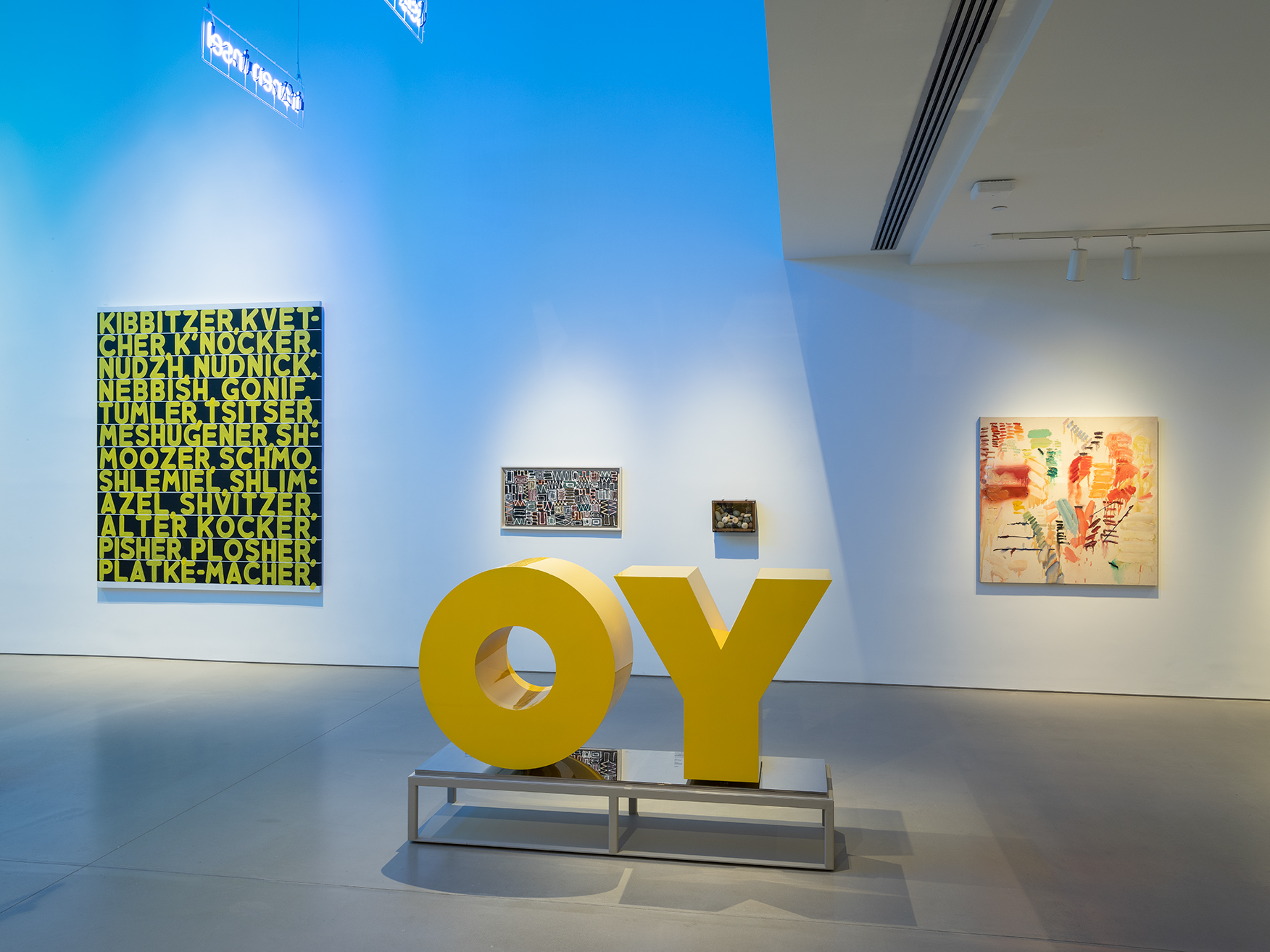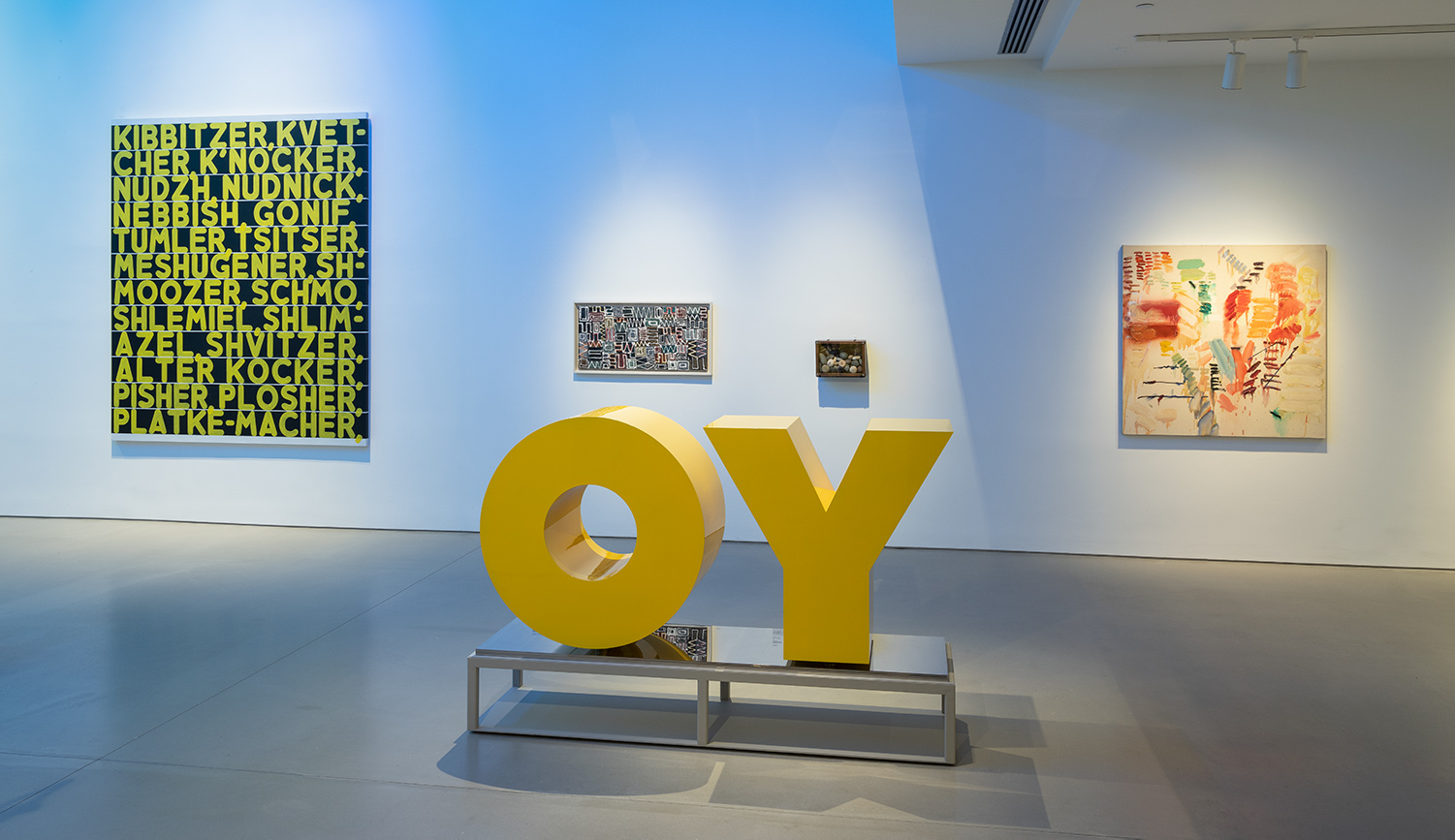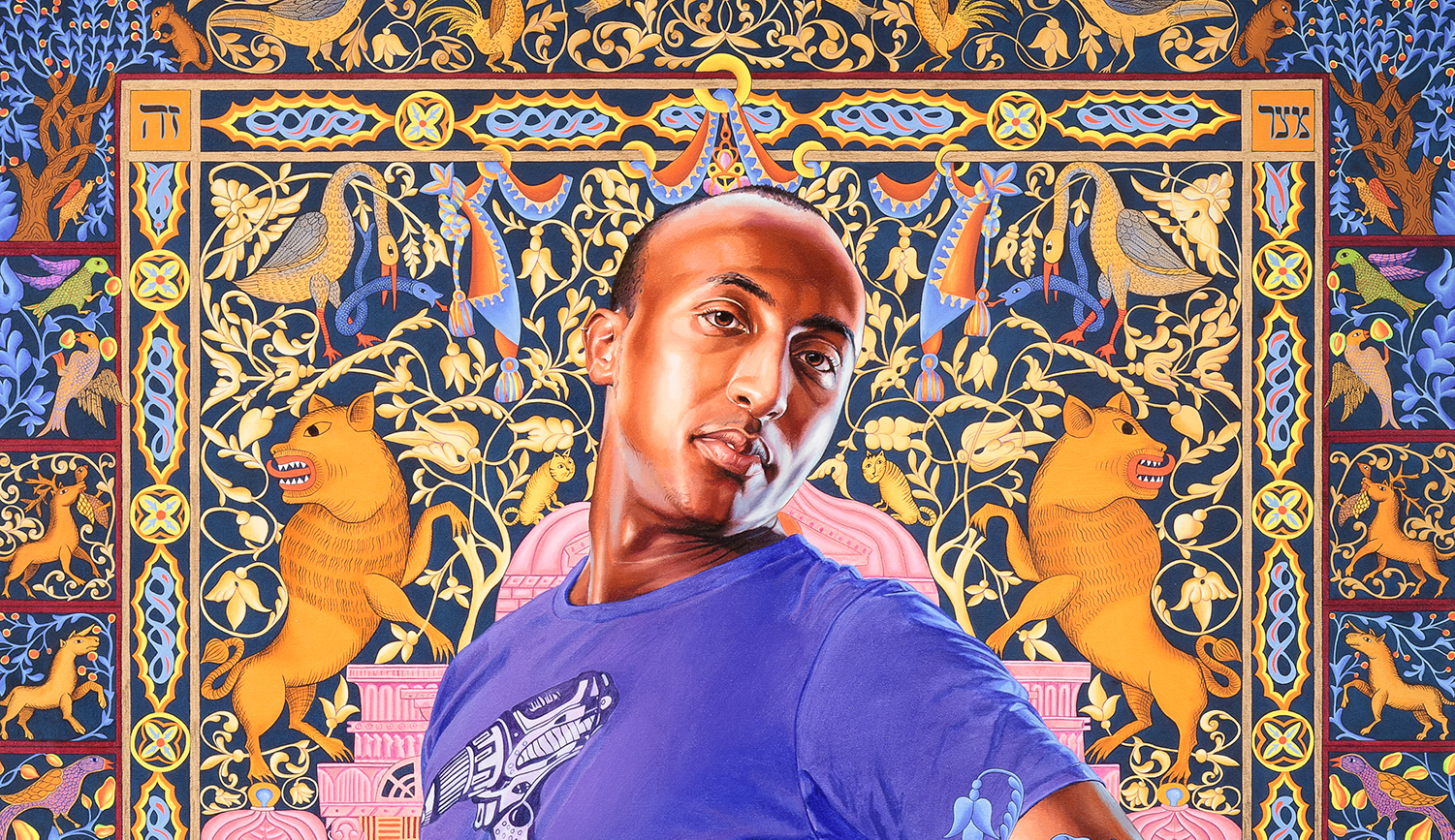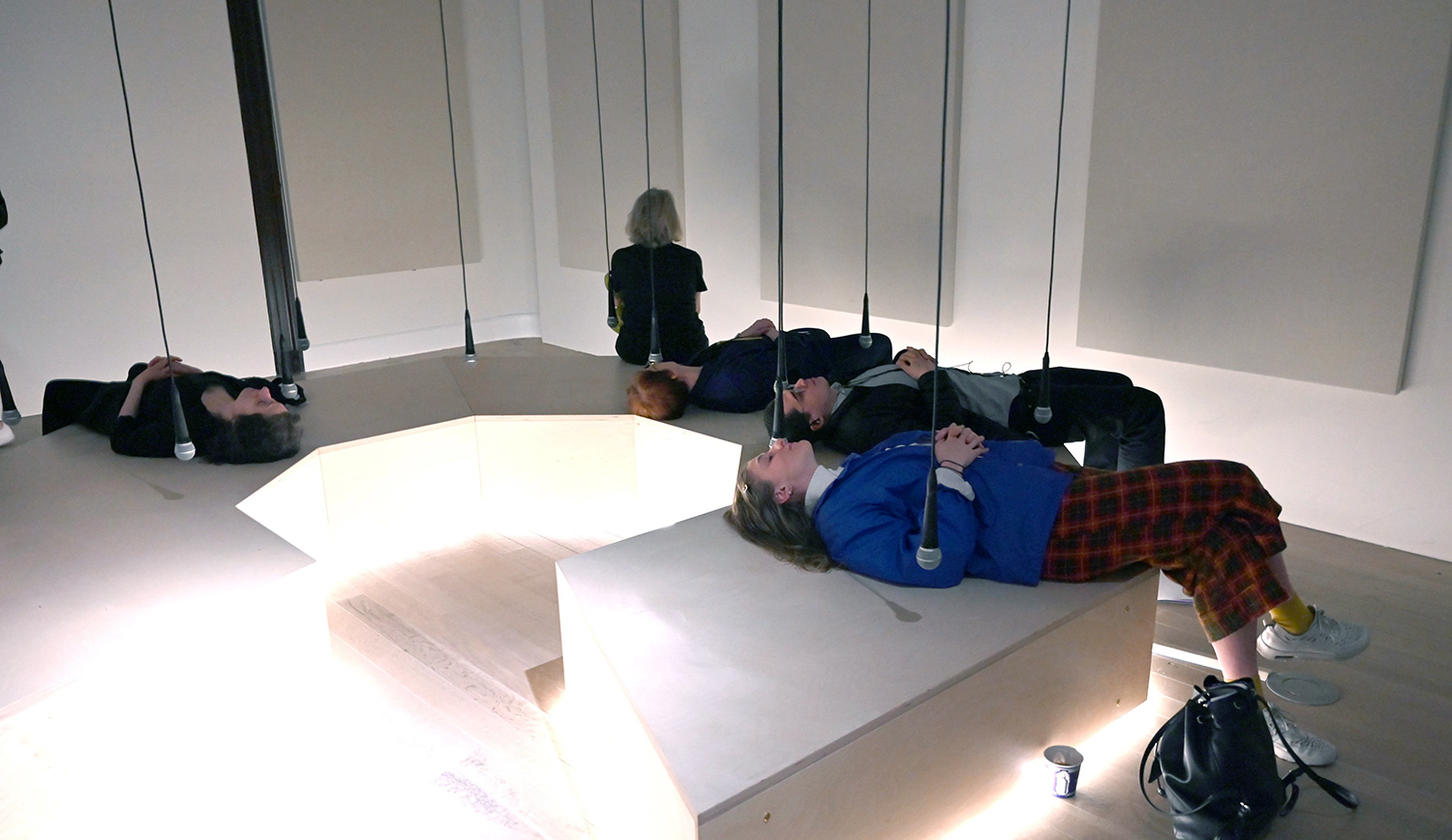A banner identifies the building at the corner of Fifth Avenue and 92nd Street—in one of the world’s most prominent neighborhoods for art—as the city’s venerable, 115-year-old Jewish Museum. Its collection of about 30,000 objects makes this among the most important such institutions anywhere and, according to its website, one of the oldest remaining Jewish museums in the world. Downstairs, at the museum’s outlet of Russ & Daughters café, customers devouring the herring, knishes, and blintzes are assured that everything on the—also venerable—menu is under kosher supervision.
Upstairs, however, is a different story. With its recent, ballyhooed revamping of its permanent exhibition, the museum has squandered a priceless opportunity to be the hub for contemporary Jewish conversation, education, and memory. In so doing, it has also departed drastically from its founding mission as a champion of Jewish culture and practice.
It wasn’t meant to be this way.
I. The First 100 Years
Founded by the Jewish Theological Seminary (JTS) in 1904, with 26 objects of mainly ritual art, the Jewish Museum finally opened to the public in the former Warburg mansion on Fifth Avenue in 1947. That year, Louis Finkelstein, the chancellor of JTS, told the New York Times that he hoped the 1,000 exhibited artworks and artifacts would celebrate “the singular beauty of Jewish life, as ordained in the laws of Moses, developed in the Talmud, and embellished in tradition.” An opening exhibit centered, appropriately enough, on the Ten Commandments. Like Finkelstein’s mission statement, it implicitly held out a standard to which every other Jewish institution might aspire.
In the 1960s, the museum diverged for a spell from its self-appointed role, developing a niche reputation as a venue for then-cutting-edge art, sometimes made by Jews. Its 1966 exhibit Primary Structures: Younger American and British Sculptors, featuring works by Donald Judd, Robert Morris, Anne Truitt, and others, is often credited as the first major U.S. show of minimalist art.
By the 1990s, following a two-and-a-half year, $36-million expansion, the museum had recovered its focus on Jewish heritage. With an emphasis on the meaning of Jewish identity, the museum’s new permanent exhibition of its central holdings, titled Culture and Continuity: The Jewish Journey, dramatically updated its prior reputation as a “fusty repository of Judaica” (to quote a news report in the Jerusalem Post). It did so, however, without traducing that reputation. As the Jerusalem Post report also noted, the exhibition took
as its central premise that Jews have been able to preserve their separate identity through twenty centuries of dispersion because of their ability to adapt to changing realities without losing their cultural core.
According to Joan Rosenbaum, then the museum’s director, most American Jews felt very comfortable identifying as Jews, but increasingly few people, Jewish or Gentile, knew what it meant to be a Jew. The exhibition, which filled two floors from 1993 to 2017, undertook to meet this silent demand, thereby making the museum, as the critic Roberta Smith put it in the Times, a home for “religious thought—unlike anything else in New York City’s rich landscape.”
How did the museum’s “religious thought” make itself manifest? Writing in Masterworks of the Jewish Museum (2004), the closest thing to a catalog of Culture and Continuity, Rosenbaum stressed the importance of context. Seeing a painting by a modern Jewish artist like Chagall, Modigliani, Pissarro, or Soutine in a museum dedicated to Jewish culture provided, she argued, “an experience that allows the paintings . . . to resonate with historical, ethnic, political, and religious references.”
In the museum’s permanent exhibition, Rosenbaum elaborated, “the emergence of the Jewish artist in the 20th century is given the context of a 4,000-year history.” To this, one might add in turn that such a context was and remains all the more important, and rare, considering the distance many 20th-century Jewish artists tried to put between themselves and their religious history—an expression of anxiety, or repudiation, that most museums and galleries have been all too happy to indulge and endorse.
I visited Culture and Continuity many times in the 2000s, and the show—divided into four sections labeled “Forging an Identity,” “Interpreting a Tradition,” “Confronting Modernity,” and “Realizing a Future”—made an undeniable impression. There was a gravitas to the installation, whose tone might almost be said to have reproduced that of the High Holy Day prayer book: respectful, sobering, thorough. Visitors who spent time with the objects and their accompanying wall labels stood not only to learn a great deal but also to get a sense of “the secret of Jewish immortality” that Mark Twain marveled at in his 1899 essay “Concerning the Jews”:
[O]ther peoples have sprung up and held their torch high for a time, but it burned out, and they sit in twilight now, or have vanished. The Jew saw them all, beat them all, and is now what he always was, exhibiting no decadence, no infirmities of age, no weakening of his parts, no slowing of his energies, no dulling of his alert and aggressive mind. All things are mortal but the Jew; all other forces pass, but he remains.
The rhetoric is grandiose, but visiting the Jewish Museum’s exhibition a century or more later, one could not help sensing that it, too, was engaged in a structurally analogous exploration of the Jewish mystery, and the experience was thrilling.
Particularly striking to me at the time was a one-third scale replica of part of a 3rd-century synagogue; so was a late-16th-century German brass cooking pot. Exceedingly rare for its time, the pot bore Hebrew lettering—thus reflecting the Frankfurt Jewish practice of placing one’s stew in a communal oven on Friday afternoon, to be reclaimed after Sabbath-morning services for a hot lunch. The Hebrew letters would facilitate the owner’s recognizing which cholent was hers.
II. “Changing Identity”
Sadly, that pot is no longer on view, and neither is its owner’s secret Jewish recipe.
Instead, we have the new permanent exhibition, blandly titled Scenes from the Collection, which opened in January 2018 nearly a year after the prior exhibition closed. The shift in focus was on stark display in the museum’s news release ahead of the opening, touting its aim to showcase “what, why, and how the museum has collected, and what this says about the changing identity of the institution and evolving intersections of art, Jewish culture, and world events.” Occupying the museum’s third floor, the exhibit consists of seven sections or “Scenes” that, rather than producing a unified narrative, are consciously meant to highlight instead the heterogeneity of the museum’s collection.
Let’s follow the curators’ intentions and take the sections one by one.
Entering the first Scene, “Constellations,” one spies from afar an aluminum sculpture by Deborah Kass that forms the word OY. Modeled on Robert Indiana’s famous (and famously kitschy) LOVE sculpture, Kass’s work, in yellow rather than Indiana’s red, improves on the latter by being readable from one side as the panicky Yiddish “oy” and from the other side as either the comforting Spanish “yo” (“I”) or the slangy English greeting “yo!”
This Scene also includes William Anastasi’s 1987 Untitled (jew): four square blank canvases, painted white and arranged to form a larger square. The word “jew,” in oversize black lowercase letters, spreads itself across the middle of the top left space, with just a serif on the final “w” overlapping onto the adjacent square. Placed together, the four unframed canvases—so a label informs us—form a cross out of the negative space between them.
As for the meaning of any of this, more below.
Meanwhile, still in the first Scene, a kind of triptych is presented. The central position is occupied by Alios Itzhak—a gigantic 2011 portrait by Kehinde Wiley. To the painting’s left hangs a small multicolor Ukrainian mizraḥ (1877): a work of signage, once more common in synagogues and in this case consisting of a paper cutout, whose purpose is to direct worshippers’ attention toward Jerusalem. To the painting’s right stands a massive, ornate wooden Torah ark, circa 1899, from a synagogue in Sioux City, Iowa.
Wiley, who isn’t Jewish, is best known for his controversial presidential portrait of Barack Obama. Here he paints his subject, an Ethiopian-Israeli Jew named Alios Itzhak, in nearly full-length, three-quarter view. (The painting’s king-sized dimensions are six-and-a-half feet wide by nine-and-a-half feet high.) Clad in a gaudily decorated purple tee shirt and jeans, with one hand cocked on his hip, Alios Itzhak gazes amusedly at the viewer over his left shoulder. Floral designs, animals, and iconography from the 1877 mizraḥ surround him—almost embedding him against its evocative pattern of the Temple in Jerusalem, complete with guardian lions of Judah. As an extra added attraction, Wiley has perched a carved wooden ornament, atop the painting’s frame, of the two tablets of the Law, protected by still more sculpted lions and human hands in the position of the priestly blessing, as if inspired by the woodwork on the adjacent ark from Iowa.
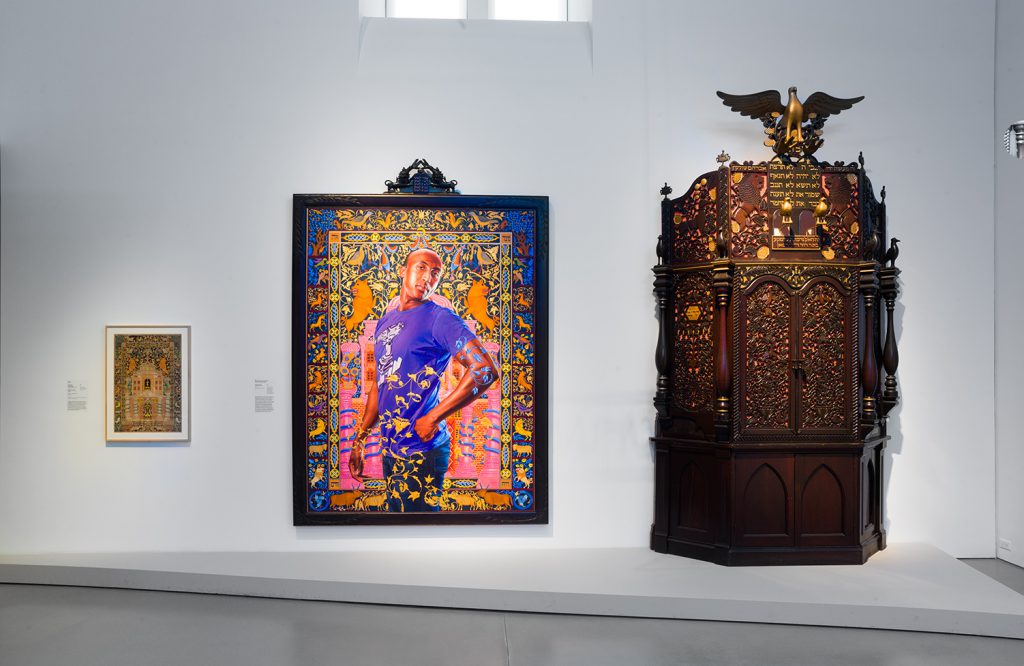
An 1877 Ukrainian mizraḥ, Kehinde Wiley’s painting of Alios Itzhak, and an ark from Iowa. Courtesy Jewish Museum.
On a neighboring wall, for supposed contrast, a vitrine houses two gorgeous, 19th-century Sephardi Torah scrolls, one from Paris and the other likely from Iraq, and around a corner—for further contrast, one must assume—is a lovely painting by Camille Pissarro (né Jacob-Abraham-Camille Pissarro, though we’re not told that) of the portal of the Gothic church Saint-Jacques in Dieppe on the Normandy coast.
All of this diversity continues opposite the Pissarro in a 2008 photograph by Anna Shteynshleyger titled City of Destiny (Schneur and Ester). It depicts a young, recently married Orthodox couple in their new home in Des Plaines, Illinois. In this photo, to which I’ll also return, the nineteen-year-old newlyweds are viewed on their porch, through a sliding door, with a length of detached and somewhat ominous-looking TV cable coiled haphazardly on the floor.
Nearby, finally, Yael Bartana’s haunting five-minute film, Entartete Kunst Lebt (Degenerate Art Lives), plays in a loop. In the film, inspired by War Cripples, a 1920 painting by the German realist Otto Dix, a parade of injured veterans proceeds incessantly from right to left. The original Dix painting was presumably destroyed by the Nazis after its inclusion in their infamous 1937 “Degenerate Art” exhibit. A wall label informs us that Dix’s crippled figures were intended to be seen as at once “suffering victims and cartoonish grotesques who participate willingly in a monstrous celebration of national pride.” Whether we’re being enjoined to see the film in the same ambiguous light is left unclear.
III. A Taxonomy of “Taxonomies”
So much for the first Scene, clearly designed to be a show-stopper and anecdotally the object of the most photos and “selfies” by visitors. The remaining Scenes can be swiftly summarized.
Second comes “Taxonomies”: a room of vitrines with very pink backs, filled with small objects ranging from ancient tombstone fragments and not-so-ancient charity boxes to jewelry and Purim noisemakers; this crowded organization is meant to evoke the kunstkammern, the “wonder rooms” or “cabinets of curiosities” that became popular starting in the 16th century. Historically, such cabinets weren’t particularly Jewish, but some included “Jewish” objects as examples of foreign fare. (Thus, a ceremonial Jewish wedding ring in the collection of the British Museum, illustrated with the creation of Eve and the sin and expulsion from Eden, recalls, as the museum notes on its website, another such object in the 16th-century collection of Albrecht V of Bavaria.)
The third Scene, “Masterpieces and Curiosities,” which looks in depth at a single object or group of objects, displays dozens of paintings and book jackets by the late graphic designer Elaine Lustig Cohen, who worked for the Jewish Museum in the 1960s. Among them is the cover of the catalog for Primary Structures, the museum’s mold-breaking 1966 exhibit on minimalism. About Cohen, the museum stresses in a press release how she helped shape its institutional identity by “directing the design of printed ephemera and catalogues for a program of art exhibitions that was among the most progressive in the nation.”
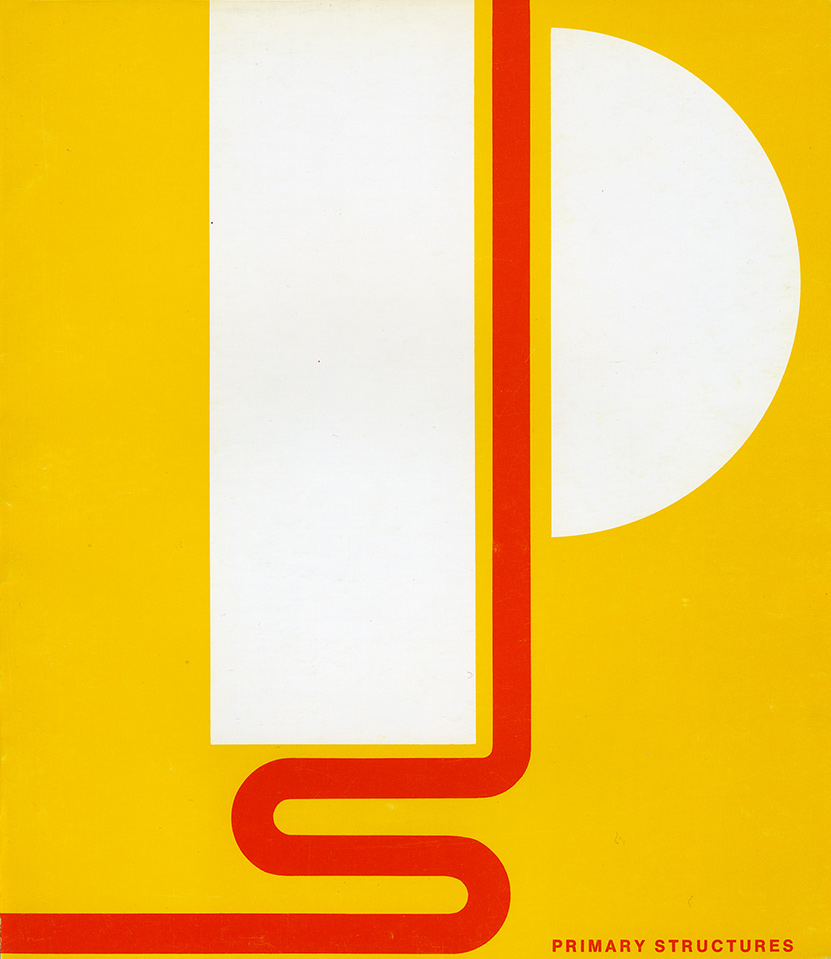
Elaine Lustig Cohen’s cover for the catalog of Primary Structures, the museum’s mold-breaking 1966 exhibit on minimalism. Courtesy Jewish Museum.
“Accumulations,” the fourth Scene, displays in vitrines 80 or so Hanukkah lamps from the museum’s collection of more than 1,000, the largest in the world. Given such capacious holdings, selecting Hanukkah lamps for this Scene—which focuses, as the title indicates, on multiples—was clearly a no-brainer. It is followed, fifth, by “Signs and Symbols,” which includes modern paintings, Holocaust art, and everything from an early-20th-century belt buckle (likely Moroccan) to a tile from the medieval El Tránsito synagogue in Toledo, Spain.
In “Television and Beyond,” the sixth Scene when I visited (it may since have been replaced), viewers could watch clips of sessions with therapists from shows like The Sopranos and Curb Your Enthusiasm.
Seventh, and last, “Personas” gives us Venus Pareve by Hannah Wilke—colorful, self-portrait nude sculptures of the artist that mimic the style of ancient statues of the goddess—with the sly “pareve,” a culinary term in kashrut signifying neither meat nor dairy, supposedly meant here to disembody or “neutralize” the sculptor’s own, overtly female form. Also in this gallery is “Double Portrait (Gay Flag)” by Ross Bleckner, a painting of a rainbow that, upon close inspection, includes a hard-to-see Star of David, presumably putting a Jewish imprimatur on the gay-rights movement. Nearby, Joan Semmel’s “Sunlight” is the kind of graphic nude that could persuade Orthodox visitors to skip this room—which would be too bad, because the opposite wall of self-portraits by Moritz Daniel Oppenheim (c. 1814-6), Louise Nevelson (c. 1935), Lee Krasner (c. 1930), and Theresa Bernstein (1914), and self-portrait-like works by Cindy Sherman (1985) and Lynn Hershman Leeson (1975), are, for the most part, of genuine merit and interest.
IV. Lip Service
As they circumnavigate the exhibition, visitors will encounter in certain Scenes a number of other meritorious works of art from the museum’s collection. They include the aforementioned Pissarro; a 1941 or 1942 crucifixion by Mark Rothko, one of the artist’s final figurative works and a reference, by dismantling the cross, to the Holocaust; and Morris Louis’s 1952 Man Reaching for a Star, which responds to the Nazi book burnings. The last-named work, as the wall label accurately states, is “unique in reflecting [Louis’s] Jewish identity”: it shows swirling brown and yellow color against a black ground, while a series of white lines, including a Star of David, appear to emerge from the picture plane.
But, as I’ve already insinuated, most of the art on display in the new permanent exhibition is, to put it gently, of decidedly inferior quality; and the same can be said of most of the artifacts, with the partial exception of some of the Hanukkah lamps, some of the ritual objects in the pink “Taxonomies” parking lot, and a few others dispersed throughout the rest of the floor. Otherwise, a stroll through the Scenes left me mostly feeling I’d been offered a series of stale one-liners from gimmicky works devoid of substance, depth, or insight. Most, paying occasional lip service to Jewish themes and content, reminded me of nothing so much as those survey findings that, for many Jews—including, on the evidence here, a significant number of Jewish artists—being Jewish means nothing more than knowing the word “oy” and eating a bagel, perhaps with lox.
This is another way of saying that the show’s real problem lies in its conception and curation, both of which faithfully reflect the Jewish Museum’s new self-image.
The problem starts with the Scenes, the titles of which alone are (deliberately?) so vague and porous, so self-referential and so self-consciously with-it, as to be largely meaningless when they are not positively befuddling. An example: “Taxonomies,” introducing cabinets of curiosities, is next to “Masterpieces and Curiosities.” Did a more logical decision—placing curiosities in a section called “Curiosities”—strike the organizers as too retrograde a nod to linearity?
If the art throughout had been of superior quality, some allowance might be made for this curatorial preference for effect over coherence, and the jumbling-up of history into an ever-present now. An exhibit spanning several centuries with, say, works by the medieval illuminator Joel ben Simeon, the 19th-century German painter Max Liebermann, and the 20th-century Russian-American painter Jules Olitski would stand on its own even if there were no real reason to throw these artists into orbit with one another and even if the labels were confounding non-sequiturs; singly and together, the quality of the works would be compelling enough to reward more than one long visit. Instead, the museum’s setting of unevenly creditable artworks in frequently witless dialogue with each other and with random Jewish “curiosities” is a sum less than even one of its parts.
As for the underlying message of this sprawling, helter-skelter, often trite show—what it is meant to express—that is less a perpetuation of Louis Finkelstein’s vision of “the singular beauty of Jewish life, as ordained in the laws of Moses, developed in the Talmud, and embellished in tradition” than an outright repudiation of both its spirit and its substance, the replacement of something infinitely dear with preening vacuities.
Consider, for example, two statements by the organizers. The very first wall text asserts categorically that, by mixing together works by artists of various provenances with equally various artifacts of Jewish culture, the museum is “affirming universal values that are shared among people of all faiths and backgrounds.” No less categorically, several press releases in the months prior to the opening stated that the show was intended to reflect “the continual evolution that is the essence of Jewish identity.”
As to the first statement, it’s true enough: the museum has indeed cherry-picked objects from its unparalleled collection of some 30,000 objects spanning 4,000 years of Jewish culture with the intention not of telling a uniquely Jewish story but, rather the opposite, of distancing itself from the idea that anything at all is unique about Judaism. In furtherance of this purpose, its promotional materials regularly go out of their way to exalt artists who “transcend” Jewish tradition in the service of those selfsame “universal values.”
How that goal is accomplished in this exhibit is unclear, but the goal itself is almost laughably suspect. As Edward Rothstein has put the point in an earlier Mosaic essay about contemporary Jewish museums in general, it’s hard to imagine any other “identity museum”—from the National Museum of the American Indian and the National Museum of African American History and Culture, both on the National Mall in Washington, to Toronto’s Aga Khan Islamic art museum and Chicago’s National Museum of Mexican Art—surrendering with such blithe breeziness its own very particular identity, let alone submerging that identity in a sea of nameless other “values.”
Worse, as if to flaunt its escape from Jewish particularity and “the singular beauty of Jewish life,” the museum goes so far as to single out traditional Jews for special insult. The label accompanying Shteynshleyger’s photograph of the Illinois newlyweds, to take one egregious example, asserts condescendingly that, although this young couple’s marriage “was not exactly arranged,” Ester and Schneur were the only two individuals of marriageable age who were suited for each other in their “close-knit, insular community.”
A dispassionate curator, let alone an informed one, would have scrapped this throwaway reference to a non-existent arranged marriage, and the merest bit of online searching would have revealed that the couple are very likely members of the Chabad movement. By so identifying them, the museum might not only have demonstrated entry-level professionalism but have helped correct widespread misconceptions that all Ḥasidim are cut from the same cloth, and have avoided belittling misnomers like “close-knit” and “insular”—especially inapplicable to Chabad, the most outward-facing of ḥasidic communities.
But that, of course, would have required the organizers to open their closed minds and perhaps even to question their own, hopelessly insular religion of “universal values.”
V. The “Essence of Jewish Identity”
What, then, of the second statement: that is, the museum’s lighting upon “continual evolution” as the very “essence of Jewish identity”? Was this the discovery responsible for the exhibition’s ignoring not only the Torah but also the centuries of traditions and customs for which many Jews were prepared to die? To the Jewish Museum, it appears, the core of Jewish identity is perpetual change, a distinctly modern romanticization of the new over any deeply held and long-practiced belief or conviction, and an insouciant betrayal of distinctly Jewish values.
This might also help explain the curators’ difficulty with the Scene devoted to 80 Hanukkah lamps and called, rather slightingly, “Accumulations,” a title justified only by reference to the common fact that museums often hold multiple examples of similar objects. Taking refuge in curatorial mumbo-jumbo, a wall text wanly states that the display “revels in the collective visual impact of multitudes, a method of presentation that reveals new insights which might otherwise remain hidden.”
Although we are never informed what those new insights might be, it occurred to me while walking through this Scene that a Jewish museum genuinely interested in evidence of “continual evolution” within Judaism could have framed it through a discussion of Jewish prayer. The Mishnah cites Rabbi Eliezer’s warning of the dangers of praying in a rote fashion, a struggle known well to any Jew who prays three times daily from prescribed medieval and early-modern scripts. This is one of many uniquely Jewish approaches to, as it might be called, serial redundancy—itself a guiding principle of Jewish thought and life and one that, as in the visual history of Hanukkah lamps, “evolves” and adapts in fidelity to the essence of Jewish identity without ever smugly pretending it is that identity.
In this last respect, consider again the exhibition’s darling: Kehinde Wiley’s Alios Itzhak, whose Hebrew inscriptions turn out to be riddled with misformed letters and misspellings. Moreover, whereas the adjacent 1899 ark from Iowa properly renders the Tetragrammaton, the too-sacred-to-be-spoken name of God, in shorthand (the Hebrew letter hey with an apostrophe), Wiley imprudently or inadvertently gives us the divine name in full.
For their part, the show’s curators, uninterested in whether the artist’s blunder was a lapse, or intentionally sacrilegious, or without any significance whatsoever, do not so much as raise a professional eyebrow at the errors in Hebrew, not to speak of their own offhand juxtaposition of a secular painting with a holy object (in this case, an ark of the Torah)—an act that in any analogous present-day museum context, especially if the perpetrators and enablers of it were white males, would be roundly denounced as the rankest form of cultural appropriation.
VI. Hierarchy/No Hierarchy
Who is responsible for this? How did this travesty, in what was previously the leading Jewish museum in America, come to happen?
In an interview with the New York Times six years ago, Claudia Gould, upon succeeding Joan Rosenbaum as the director of the Jewish Museum, avowed her special partiality to just this habit of juxtaposing secular and sacred objects. “There is no hierarchy,” she said, “between a kiddush cup and a painting by George Grosz, and I love that.” (Grosz was part of the same Neue Sachlichkeit movement as Otto Dix. Neither one was Jewish.)
This claim is both incomprehensible and wrong. There absolutely is a hierarchy between a ritual object and a secular canvas—that is, if one acknowledges, as the museum simply fails to do, that Judaism is a religion very much alive today. To put it at its simplest, certain ritual objects either are sacred in their own right or take on sacred-like properties in being used as accessories to the performance of mitzvot, commandments. The museum need not endorse this fact, although it wouldn’t hurt a Jewish museum to do so; but it might evince some awareness of its existence.
It also wouldn’t hurt a Jewish museum to have at its helm a director who is a careful and involved student of Judaism. But, for the museum’s board, that never seemed to be a priority. Far from it, at least if one reads early announcements of Gould’s hiring. A Times story at the time noted that the Jewish Museum’s board, in hiring someone like Gould with a résumé heavy on contemporary art, was aiming to infuse “more dynamism and fresh ideas into this 107-year-old institution on the Upper East Side of Manhattan.” Another Times article disclosed that until she took the job, Gould, who had grown up in an interfaith home with a Jewish father and a Roman Catholic mother, didn’t know that Judaism is a matrilineal religion. Brushing this aside, a board member was quoted as saying that her experience would enable her to communicate fluently with interfaith audiences.
Undoubtedly, it is a bonus for the leader of an identity museum to feel comfortable engaging with broader audiences. Still, one would expect this to be regarded as a secondary skill, certainly when weighed against greater expertise in the museum’s core collection and the ideas and practices that birthed it. Nor is there a religious test for directing a Jewish museum; indeed, some of the keenest scholars of Jewish history and ritual practice have been non-Jews. But they still had to do their homework, and evince the drive to master the texts and values of the communities they were studying.
Entirely missing from the Jewish Museum’s new permanent exhibition is any recognition of the fundamental Jewish distinction between the sacred (kodesh) and the secular or prosaic (ḥol). And that is only one reason why, incredible as it may sound, Jews or others who hope to witness Jewish history, culture, and practice being treated thoughtfully and respectfully would likely benefit more from visiting the Christian-sponsored and much-maligned Museum of the Bible in Washington, DC than from traipsing through the Jewish-sponsored Jewish Museum in New York.
Those responsible for the Bible Museum’s exhibits have not only gone out of their way to consult with Jewish historians and biblical scholars, but made it crystal-clear that for them Judaism is a living, breathing religion. This message is brought home both in the museum’s displays (including videos in which actors explain, for example, who Maimonides was) and in the presence of a real-life scribe (sofer), hired by the museum to sit in the galleries while writing a Torah scroll and engaging visitors in conversation: an amazing learning opportunity for countless museum-goers who may have never spoken with a religious Jew, let alone a scribe.
In his science-fiction novella The Time Machine (1895), H.G. Wells has his time-traveling narrator visit a Palace of Green Porcelain that turns out to be a museum in ruins. Among the detritus he finds decayed books—evidence of the human race’s tireless energy and ambition that has given way to the Eloi and the Morlocks. The narrator’s reaction:
Had I been a literary man I might, perhaps, have moralized upon the futility of all ambition. But as it was, the thing that struck me with keenest force was the enormous waste of labor to which this somber wilderness of rotting paper testified.
There’s something very haunting about a museum that testifies to extinction—to things of the past fit only for commemoration in curiosity cabinets. Jews and Judaism, in all of their ceaseless originality and particularity, are not and have never been such things; look around, or ask Mark Twain. So why should the Jewish Museum, or Jewish institutions like it, under any self-justifying banner, join itself with any such enterprise, when it has the resources and the capacity to do exactly the opposite?
More about: Arts & Culture, Jewish art, Jewish museum, Museums
